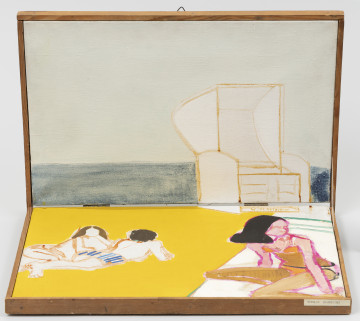
Lamu of the Future
2009 — 2023
National Museum in Szczecin
Part of the collection: Genre scenes
Idyllic, undisturbed, peaceful and carefree moments spent on the beach in the warm rays of the July sun – this is how one can describe the painterly postcard by Ludwik Misky, whose characters enjoy the golden sand under their feet, the steady murmur of the waves breaking on the shore and the refreshing summer wind. However, the familiar seaside holiday frame was uncommon until 1918. It was then that Poland, having regained its independence, again gained access to the Baltic Sea, and the symbolic wedding with the sea in 1920 was of great political and economic importance as well as influencing the development of tourism in the inter-war period. The creation of the Free City of Gdansk and the rapid development of railways and coastal shipping contributed to the popularisation of the Polish coast. Thus, in a short period, small coastal villages transformed into summer resorts, which holidaymakers from all over the country visited during the warm summer months. However, the Hel Peninsula was the most frequently visited. The journey from Puck to Hel was a great adventure at the time; Stefan Żeromski's daughter, Monika, recalled the holiday journey in the following way: ‘The train rolls between two seas on a narrow piece of land, the shine is coming from the tiny waves on both sides, and only the grey, sharp grasses obscure the lovely, close water’.
Hel, Swarzewo, Chałupy, Kuźnica, Jastarnia and Władysławowo (formerly Wielka Wieś) could not, however, match the extraordinarily charming Jurata, which became one of the favourite resorts of, among others, President Ignacy Mościcki and Cracovian artists such as Wojciech Kossak or Ludwik Misky, whose seaside reminiscences of a sunny day on the beach we can now see.
During the summer months, the Polish coast provided summer visitors with many attractions in addition to sandy beaches so that they did not suffer from boredom. Thus, no one was surprised to see jugglers or travelling theatre troupes appearing on the seaside promenades. Additionally, cruises, horse races, sports tournaments and Miss Gdynia elections were organised, and you could also play croquet. However, the most awaited were the dancing parties often organised outdoors and lasting until late at night.
Author / creator
Dimensions
cały obiekt: height: 68,8 cm, width: 49,6 cm
Object type
painting
Technique
oil technique
Material
cardboard, oil-based paint
Creation time / dating
Creation / finding place
Owner
The National Museum in Lublin
Identification number
Location / status

2009 — 2023
National Museum in Szczecin

2008
National Museum in Szczecin

1969
National Museum in Szczecin
DISCOVER this TOPIC
Museum of King Jan III's Palace at Wilanów
DISCOVER this PATH
Educational path